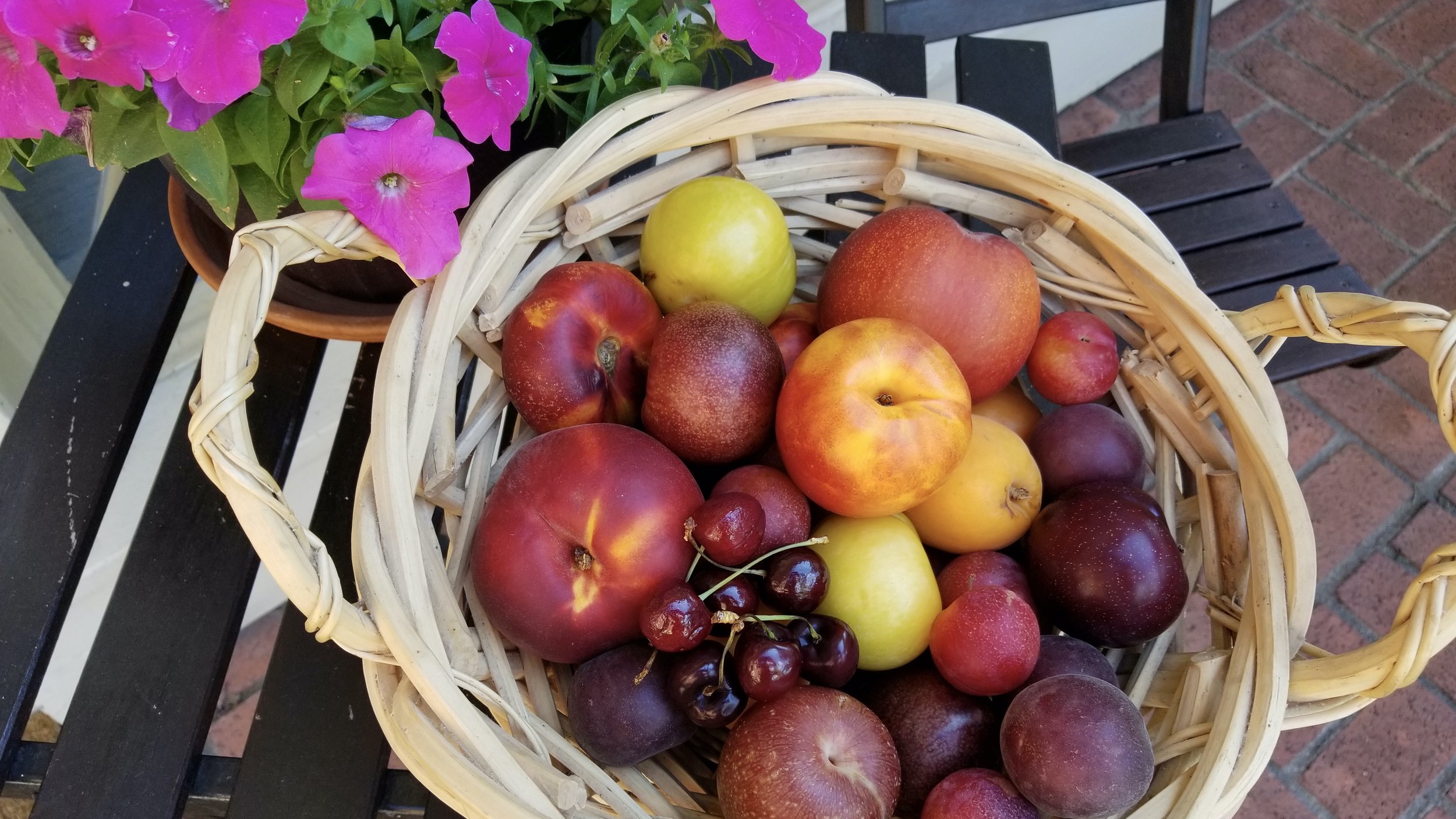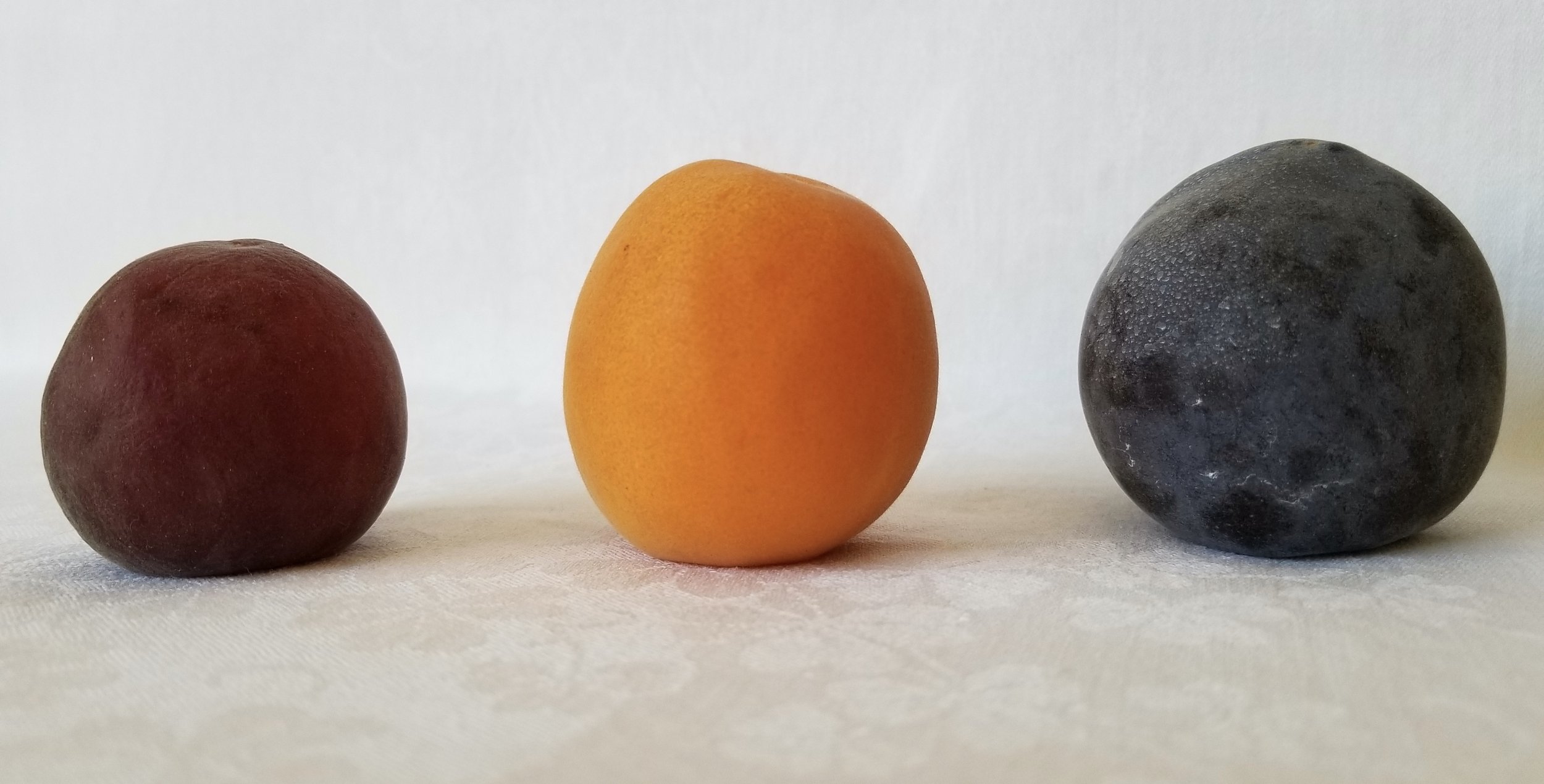STONE FRUITS
A basket of assorted summer stone fruits.
Someone please tell the plum tree about the birds and the bees. Mister Plum’s been fooling around a lot with some other trees.
Wait. On second thought, it’s the bees that are the problem.
You know those oddly named fruits at the market? The plumcots (green, red, dappled and black), the pluot, aprium, and velvet apricot, to name just a few.
The plum tree’s doing it with the apricot tree. The two have sensible, if not very creative, ways of naming their offspring. Plum plus apricot equals “plumcot,” for example, or, in the case of the aprium, “apri” from apricot stuck to “um” from plum.
Um.
And the peach tree’s cozying up to the nectarine tree and makin’ peacharines. The plum and the cherry trees are gettin’ it on and birthin’ cherry plums.
It’s peachy times in the old orchard at night.
All of these (and several other fruits such as cherries and regular peaches and plums) are called stone fruits due to the inedible lignified (woody) pit or stone in their centers. Another, more botanical, name for them is drupe.
It’s hard to believe, but raspberries and blackberries aren’t berries at all, but aggregates of dozens of drupelets, hence clusters of many wee stone fruits. Wild, eh?
Localized stone fruit seasons are short, typically a month or so, after which stone fruits must be trucked in from other climes that are enjoying their own time in the sun.
But while they are at their peaks, stone fruits are some of the more delicious, and healthy, fruits that we can eat—high in antioxidants, minerals and vitamins, of course low in fat, and unusually helpful to digestion due to their high fiber quotient.
Planet apricot, from left to right: a black velvet apricot, a Blenheim apricot, an aprium
I have been eating many different stone fruit in preparation for this posting and I must say that some of them have been mind-blowingly delicious. A few squat “yellow donut nectarines”—they look like fruit bialys—were chin-dripping juicy and so concentrated in flavor and scent you could rightly call them perfumed.
I bit into a black-red aprium and it squirted its super-sweet, beet-red juice all over my keyboard (what do I know from apriums?) but, gosh, it was terrifically tasty. And, gotta say, those peacharines are wonderful, big like a peach but fuzzless, and oh-so nectarine-y.
All those kids from the mating of plum and apricot trees line themselves up on a sort of stone fruit Kinsey scale. At, say, the left end is the plain apricot, and at the far right is the plain purple plum. Second from the left, next to the apricot, is the aprium, two-thirds or so apricot, one-third plum. Then the plumcot, 50 percent of each parent.
A pluot (pronounced plue-oh) is next, closest to the plum, one-third or so apricot, the rest Mister Plum. You’d think that the closer a plumcot or pluot were lined up to its dominant parent, the more that it would taste of it. But some plumcots I had (the green plumcot, for example) were much more plum-like—that is, tart, even tannic—than apricot-y. And there was that Super Soaker of an aprium. It may be only one-third Mister Plum, but plumness certainly dominated its personality.
In season, buy stone fruits when they’re firm but not hard, free of soft spots or wrinkling. They ripen well, especially in brown papers bags (remember those?) and always at room temperature. When ripe, they may be kept refrigerated for a few days.
The key to max enjoyment is just to ripen before refrigerating.
I’ve learned that it is best to wash them right before they’re to be enjoyed, rather than before ripening. I generally eat the skins wherein lies a lot of flavor, scent, and nutrients.
Some stone fruits are “freestone,” in which the pit parts easily from its surrounding flesh; some are “clingstone,” in which it does not. Just don’t try to eat or swallow the pits unless, as my mother would warn, “you want a cherry tree to grow from your tummy.”
And, personal advice here, eat them in moderation. In my 20s, I ate a kilo (2.2 pounds) of my beloved apricots in one sitting, tossing the pits out the window of a car on a long drive through backcountry France. I couldn’t help myself, and the last was a delicious as the first.
But, true to the promise of stone fruit’s digestive boost, um, aid ran for close to five days.
RECIPE: Plumcot Monte Cristo sandwich
Adapted from familytreefarms.com; makes 2
Ingredients
2 eggs
3 tablespoons milk or cream
1/2 teaspoon nutmeg
1/2 teaspoon kosher salt
1/2 teaspoon freshly ground black pepper
4 slices thick sourdough or other white bread
4 tablespoons softened unsalted butter, divided in half
4 teaspoons Dijon mustard
10 ounces thinly sliced ham
1 cup pitted, thinly sliced plumcots
1 cup of shredded Gruyère cheese
Powdered sugar for dusting
Directions
In a large shallow dish, whisk together eggs, milk, nutmeg, kosher salt and black pepper until smooth. Coat 1 side of each slice of bread with an even layer of 1/2 of the butter and the mustard. Lay the slices out, butter and mustard side up, into 2 pairs. Divide the ham onto 2 of the slices; then the cheese onto the other 2 slices. Lay the slices of plumcots evenly over all. Carefully place the slices together to form 2 sandwiches.
Carefully dip each sandwich into the egg mixture on both sides to evenly coat. Heat a medium-sized cast-iron skillet with the other 1/2 of the butter. Once butter has melted, fry sandwich on each side for 2-3 minutes or until golden brown. Dust the tops of sandwiches with powdered sugar for a classic Monte Cristo.

